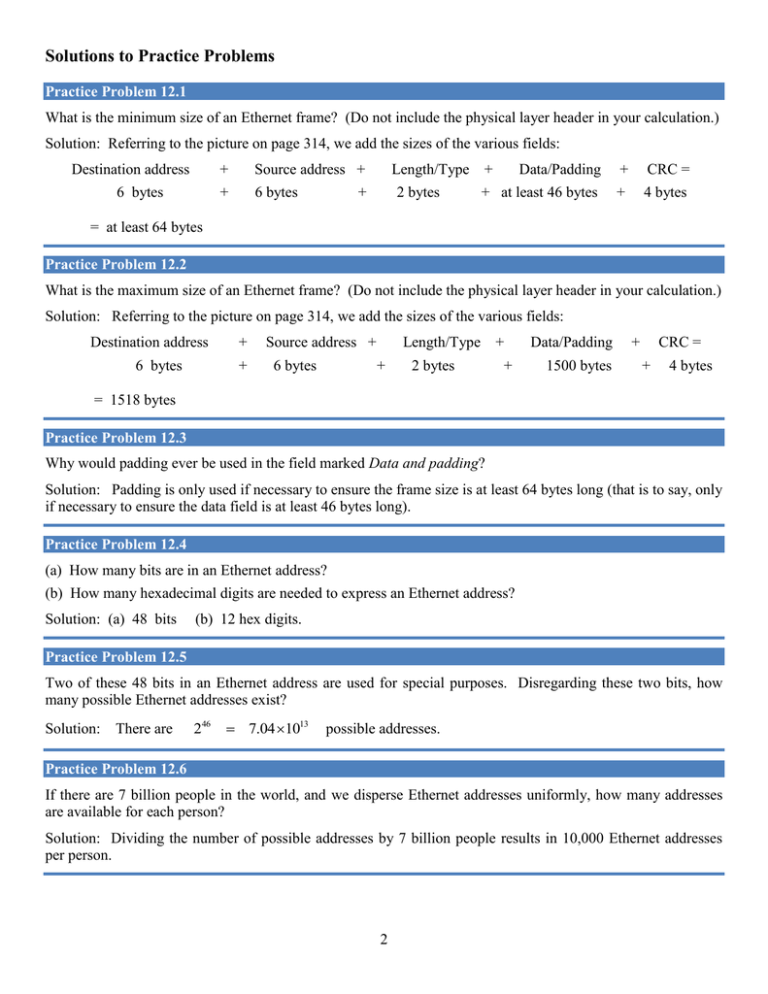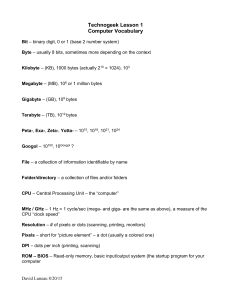Solutions to Practice Problems
advertisement

Solutions to Practice Problems Practice Problem 12.1 What is the minimum size of an Ethernet frame? (Do not include the physical layer header in your calculation.) Solution: Referring to the picture on page 314, we add the sizes of the various fields: Destination address 6 bytes + Source address + + 6 bytes Length/Type + + 2 bytes Data/Padding + CRC = + at least 46 bytes + 4 bytes = at least 64 bytes Practice Problem 12.2 What is the maximum size of an Ethernet frame? (Do not include the physical layer header in your calculation.) Solution: Referring to the picture on page 314, we add the sizes of the various fields: Destination address 6 bytes + + Source address + 6 bytes Length/Type + + 2 bytes + Data/Padding 1500 bytes + CRC = + 4 bytes = 1518 bytes Practice Problem 12.3 Why would padding ever be used in the field marked Data and padding? Solution: Padding is only used if necessary to ensure the frame size is at least 64 bytes long (that is to say, only if necessary to ensure the data field is at least 46 bytes long). Practice Problem 12.4 (a) How many bits are in an Ethernet address? (b) How many hexadecimal digits are needed to express an Ethernet address? Solution: (a) 48 bits (b) 12 hex digits. Practice Problem 12.5 Two of these 48 bits in an Ethernet address are used for special purposes. Disregarding these two bits, how many possible Ethernet addresses exist? Solution: There are 246 7.04 1013 possible addresses. Practice Problem 12.6 If there are 7 billion people in the world, and we disperse Ethernet addresses uniformly, how many addresses are available for each person? Solution: Dividing the number of possible addresses by 7 billion people results in 10,000 Ethernet addresses per person. 2 Practice Problem 12.7 How many possible Ethernet addresses exist for each individual vendor? Solution: There are 224 = 16,777,215 possible address per vendor. Note that many companies have more than one such block of addresses. Practice Problem 12.8 Express the Ethernet address in hexadecimal. Figure 13.15broadcast A network with and without a bridge Solution: FF:FF:FF:FF:FF:FF Practice Problem 12.9 What is the bandwidth available to each of the users on the 10 Mbps Ethernet shown below? Solution: 10Mbps / 12 users = 833 kbps. Practice Problem 12.10 What is the bandwidth available to each of the users on the 10 Mbps Ethernet shown below? 13.25 Solution: 10 Mbps/ 9 users = 1.11 Mbps Practice Problem 12.11 Consider the 10 Mbps Ethernet shared by the busy users in the network below. The network uses three 5-port hubs. How much bandwidth is available to each user? Solution: 10 Mbps / 6 = 1.67 Mbps. 3 Figure 13.15 A network with and without a bridge Figure 13.15 A network with and without a bridge Practice Problem 12.12 Consider users employing 10 Mbps Ethernet. How much bandwidth does each user get in each of the three scenarios below. (a) Scenario 1: (b) Scenario 2: (c) Scenario 3: 13.25 13.25 Solution: (a) One collision domain: 10 Mbps / 12 users = 833 kbps (b) Two collision domains: 10 Mbps / 7 users = 1.428 Mbps (c) Four collision domains: 10 Mbps / 4 users = 2.5 Mbps Practice Problem 12.13 You have set up an Ethernet LAN for 10 users. For simplicity, assume the network has an efficiency of 100% and that resources are shared equally among users. How much bandwidth is available to each user if: (a) The 10 users are connected on a 10 Mbps Ethernet to a hub. (b) The 10 users are connected on a 10 Mbps switched Ethernet Solution: (a) 1 Mbps per station. (b) 5 Mbps since, for practical purposes, each user shares his own 10 Mbps Ethernet LAN with the switch. Practice Problem 12.14 You want to set up an Ethernet LAN for a group of 10 offices at the Pentagon. Each office requires 2 digital telephone lines (64 kbps each). Additionally, each office must support a peak web browsing demand of 40,000 bytes/min. (a) What is the total bit rate demand of the LAN? (b) Would a standard 10 Mbps Ethernet suffice? Solution: (a) Each of the offices requires 2(64,000) + (40,000)(8)/60 = 133,333 bits/sec. Since there are 10 offices, the total demand is 1.33 Mbps. (b) Yes. 4 Practice Problem 12.15 Match column on the left with the description on the right: Network Interface Card (a) Looks at MAC address and then forwards the frame on the correct port Hub (b) Copies incoming bits to all other ports Switch (c) Piece of equipment with a unique address that translates bits to signals and transmits the signals on the medium. Solution: Top to bottom: (c) , (b), (a) Practice Problem 12.16 If an entire IP packet has 8096 bytes, how many Ethernet frames are required to transmit this packet? Solution: An Ethernet frame has a maximum of 1500 bytes in the data portion, so 8096 /1500= 5.4 so we would need 6 frames. Practice Problem 12.17 Answer True or False to the following statements: (a) An Ethernet address is normally expressed in decimal. (b) An Ethernet address is burned into hardware and never changes (c) An Ethernet address is used at the network layer to address packets. (d) An Ethernet address, MAC address, and Hardware address are all the same thing. (e) When I log on to different networks my Ethernet Address can change every time. Solution: (a) False (b) True (c) False 5 (d) True (e) False






